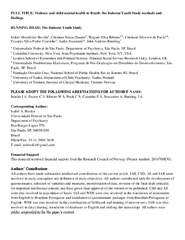Violence and child mental health in Brazil: The Itaboraí Youth Study methods and findings
Permanent link
https://hdl.handle.net/10037/13986Date
2018-01-17Type
Journal articleTidsskriftartikkel
Peer reviewed
Author
Bordin, Isabel AS; Duarte, Cristiane S.; Ribeiro, W.S.; Paula, C.S.; Coutinho, Evandro Silva Freire; Sourander, A; Rønning, John AndreasAbstract
Objectives: To demonstrate a study design that could be useful in low‐resource and violent urban settings and to estimate the prevalence of child violence exposure (at home, community, and school) and child mental health problems in a low‐income medium‐size city.
Methods: The Itaboraí Youth Study is a Norway–Brazil collaborative longitudinal study conducted in Itaboraí city (n = 1409, 6–15 year olds). A 3‐stage probabilistic sampling plan (random selection of census units, eligible households, and target child) generated sampling weights that were used to obtain estimates of population prevalence rates.
Results: Study strengths include previous pilot study and focus groups (testing procedures and comprehension of questionnaire items), longitudinal design (2 assessment periods with a mean interval of 12.9 months), high response rate (>80%), use of standardized instruments, different informants (mother and adolescent), face‐to‐face interviews to avoid errors due to the high frequency of low‐educated respondents, and information gathered on a variety of potential predictors and protective factors. Children and adolescents presented relevant levels of violence exposure and clinical mental health problems.
Conclusions: Prevalence estimates are probably valid to other Brazilian low‐income medium‐size cities due to similarities in terms of precarious living conditions. Described study methods could be useful in other poor and violent world regions.


 English
English norsk
norsk